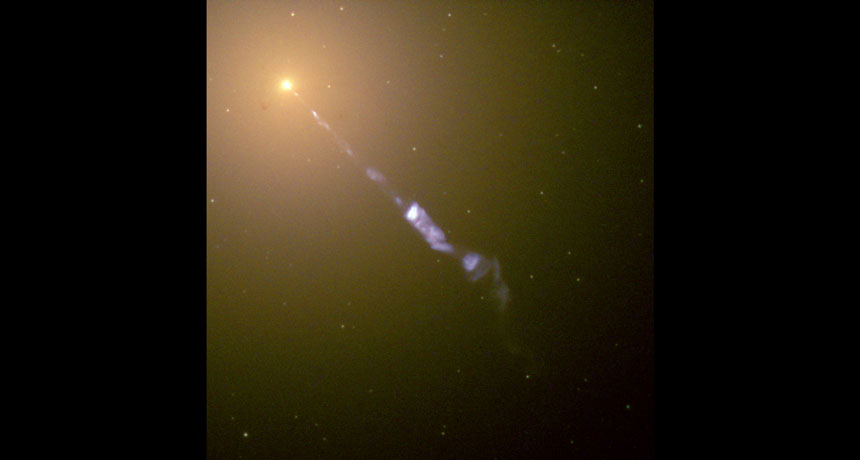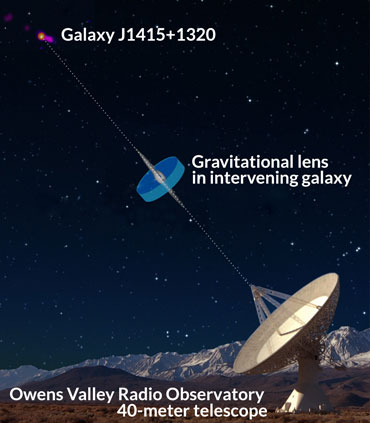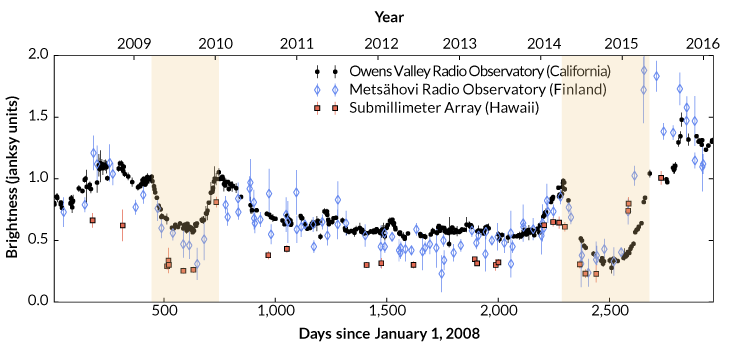Cosmic lens lets astronomers zoom in on a black hole’s burps
Seeing into the heart of a faraway galaxy could explain how jets of hot material get their start

REACHING OUT Many supermassive black holes shoot jets of hot material thousands of light-years into space, like this one emerging from the galaxy M87 about 50 million light-years away. Now scientists have seen the beginnings of such a jet from a galaxy billions of light-years away.
Hubble Heritage Team (AURA/STScI), NASA, ESA
Astronomers have caught their best look ever at blobs of hot gas fleeing a supermassive black hole, thanks to a new kind of cosmic magnifying glass.
Anthony Readhead of the Owens Valley Radio Observatory at Caltech and colleagues caught two small, hot bursts traveling away from a bright galaxy called J1415+1320 at near the speed of light. Although the galaxy is billions of light-years away and the blobs are tiny compared with the galaxy, it appears that a lucky alignment of stars may have created what’s called a gravitational lens, magnifying the galaxy and its environs.
“We’re peering right down into the core of the nucleus of this active galaxy,” Readhead says. “We think this is potentially a very powerful new window.” The researchers report their findings August 20 in two papers in the Astrophysical Journal.
J1415+1320 is what’s known as a blazar, a bright galaxy with a gluttonous supermassive black hole at its center (SN: 3/4/17, p. 13). The black hole is actively feeding on a disk of white-hot gas that swirls around it, making the host galaxy glow brightly in gamma and radio waves. The galaxy is among about 1,800 blazars that Readhead and his team have observed twice a week since 2008. “Nobody has looked at the sky quite like that before,” he says.
Starting in 2009, J1415+1320 started doing something extremely strange. Over the course of about a year, the blazar grew brighter, then dimmer, then brighter again. Plotting its brightness over time revealed a symmetrical U shape in the data.
At first, the team thought the change was caused by a cloud of plasma within the Milky Way that happened to pass between Earth and the blazar, scattering its light. But then the same thing happened again in 2014.
Conversations with colleagues at other observatories revealed that the galaxy behaved the same way when observed in many electromagnetic wavelengths, not just with a radio telescope. That wouldn’t happen if a stray cloud of plasma were to blame.
Now, Readhead and his colleagues argue that they’re seeing the blazar’s black hole emit tiny burps of plasma, magnified hundreds of times by a new kind of gravitational lens. These cosmic lenses are massive objects that can bend the path of light passing by them, making sources of light in the background look distorted from the point of view of telescopes on Earth. Astronomers can use this distortion to learn about the background objects and their lenses.
So far, all known lenses have either been enormous — millions of times the mass of the sun, like an entire galaxy — or relatively tiny, like a single planet.
The lens that magnified J1415+1320 seems to be something in between, from 1,000 to 1 million times the mass of the sun. It is about 2.7 billion light-years away, and is associated with a spiral galaxy, but is less massive than the entire galaxy. The lens could lie within or nearby the galaxy, and could be a collection of thousands of stars like a globular cluster. Or it could be something more exotic, like difficult-to-spot midsize black holes.
The U-shaped features in the data appeared when the black hole emitted clumps of matter that sped away at near the speed of light, and passed behind this lens from the perspective of Earth, the team says.
“This was an extremely interesting, unique observation,” says astrophysicist Eileen Meyer of the University of Maryland, Baltimore County. “As far as I know, there’s nothing like that that has been observed before.”
Readhead’s team still needs to make more observations to confirm that the lens is real. But if it is, it could help solve an outstanding mystery about black holes: how they shoot jets of hot charged particles into space. Many active galaxies display these brilliant jets, but their origins are mysterious.
“We actually don’t know how these jets are launched,” says Harish Vedantham, also of Owens Valley Radio Observatory and a coauthor of the new papers. “We don’t have definitive answers because we can’t make an image on the [size] scales of where this emission is happening.”
The new observations of J1415+1320 are not quite such an image. But they suggest a way to someday produce one. The lens magnified the black hole 100 times more than is possible with current telescopes, so more observations could help reveal more about its nature.
“This is like a stepping-stone,” Vedantham says. “This is a possible technique to go in and get this high-resolution view of how a black hole is launching these jets.”
If further observations rule out the lens, then things could get even stranger. “If it’s not a gravitational lens, then it’s an intrinsic property of the jets themselves,” Readhead says. “Then it will have interesting implications for the physics of the actual jet. I think it’s a win-win situation.”









